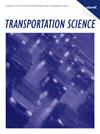Matching vs. Individual Choice: How to Counter Regional Imbalance of Carsharing Demand
IF 4.8
2区 工程技术
Q1 OPERATIONS RESEARCH & MANAGEMENT SCIENCE
引用次数: 1
Abstract
Among the most crucial organizational challenges of free-floating carsharing is the question how to cope with regional demand imbalance. Because users are allowed to leave a rented car anywhere in the service district, it regularly occurs that too many cars are left behind in low-demand regions whereas other regions face a demand surplus. In this paper, we consider a countermeasure that has been overlooked by previous research: an optimization-based matching of carsharing supply and demand that not only addresses the profit promised by the current matches but also targets future demand imbalance. To account for such imbalances, we define regional demand levels that specify the projected number of requested cars per region and aim to reduce the deviations of the regions’ actual car supply from these target levels. We present exact polynomial-time algorithms for this extended matching task that are suitable for real-time application on large carsharing platforms. In an extensive computational study, we compare optimization-based matching approaches with and without the consideration of demand imbalance and benchmark them with the status quo, the individual choice of carsharing users among available cars. Based on generated data with considerable demand variation among regions, our results indicate a clear advantage of our novel matching approach. In a further study based on a large carsharing data set, however, the proof of concept fails because the real-world regions are cut according to geographical characteristics instead of demand variation. To successfully relieve the strains of demand imbalance, our novel matching task thus requires a properly partitioned service district and reliable forecasts of the carsharing demands.Funding: This work was supported by the Deutsche Forschungsgemeinschaft [Grants BO 3148/8-1 and BR 3873/10-1].Supplemental Material: The online appendix is available at https://doi.org/10.1287/trsc.2022.0067 .匹配与个体选择:如何应对拼车需求的区域不平衡
自由浮动式共享汽车最关键的组织挑战之一是如何应对地区需求不平衡的问题。因为用户可以把租来的车停在服务区的任何地方,所以经常会出现在低需求地区留下太多的车,而其他地区则面临需求过剩的情况。在本文中,我们考虑了一个被以往研究忽视的对策:基于优化的汽车共享供需匹配,既解决了当前匹配所承诺的利润,也解决了未来需求失衡的问题。为了解释这种不平衡,我们定义了区域需求水平,该需求水平指定了每个地区预计的汽车需求数量,并旨在减少该地区实际汽车供应与这些目标水平的偏差。我们提出了适合于大型汽车共享平台实时应用的精确多项式时间算法。在广泛的计算研究中,我们比较了考虑需求不平衡和不考虑需求不平衡的基于优化的匹配方法,并将其与现状进行基准测试,即汽车共享用户在可用汽车中的个人选择。基于区域间需求差异较大的生成数据,我们的结果表明我们的新匹配方法具有明显的优势。然而,在基于大型汽车共享数据集的进一步研究中,概念证明失败了,因为现实世界的区域是根据地理特征而不是需求变化来划分的。为了成功地缓解需求不平衡的压力,我们的新匹配任务需要适当划分服务区和可靠的汽车共享需求预测。资助:本研究得到了德国科学研究基金会(Deutsche Forschungsgemeinschaft)的支持[赠款BO 3148/8-1和BR 3873/10-1]。补充材料:在线附录可在https://doi.org/10.1287/trsc.2022.0067上获得。
本文章由计算机程序翻译,如有差异,请以英文原文为准。
求助全文
约1分钟内获得全文
求助全文
来源期刊

Transportation Science
工程技术-运筹学与管理科学
CiteScore
8.30
自引率
10.90%
发文量
111
审稿时长
12 months
期刊介绍:
Transportation Science, published quarterly by INFORMS, is the flagship journal of the Transportation Science and Logistics Society of INFORMS. As the foremost scientific journal in the cross-disciplinary operational research field of transportation analysis, Transportation Science publishes high-quality original contributions and surveys on phenomena associated with all modes of transportation, present and prospective, including mainly all levels of planning, design, economic, operational, and social aspects. Transportation Science focuses primarily on fundamental theories, coupled with observational and experimental studies of transportation and logistics phenomena and processes, mathematical models, advanced methodologies and novel applications in transportation and logistics systems analysis, planning and design. The journal covers a broad range of topics that include vehicular and human traffic flow theories, models and their application to traffic operations and management, strategic, tactical, and operational planning of transportation and logistics systems; performance analysis methods and system design and optimization; theories and analysis methods for network and spatial activity interaction, equilibrium and dynamics; economics of transportation system supply and evaluation; methodologies for analysis of transportation user behavior and the demand for transportation and logistics services.
Transportation Science is international in scope, with editors from nations around the globe. The editorial board reflects the diverse interdisciplinary interests of the transportation science and logistics community, with members that hold primary affiliations in engineering (civil, industrial, and aeronautical), physics, economics, applied mathematics, and business.
 求助内容:
求助内容: 应助结果提醒方式:
应助结果提醒方式:


